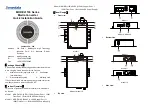
Aquair 100
TM
Manual
© Ampair
®
, 2007
www.ampair.com
Page 18 of 23
AQUAIR OPERATION & PERFORMANCE
Operation – Water Mode:
It is assumed that the Aquair has been installed in accordance with the INSTALLATION section and
that the water turbine and towrope are attached.
Streaming:
Lay the towrope out on the deck in such a way that it can be played out without risk of
snagging or knotting when the turbine is put in the water. This should be done when the boat is under
way. Slight tension should be applied as it runs out to prevent the turbine grounding in shallow water.
The towrope should not pass close to steering gear etc., which could cause chafing or worse.
CAUTION:
The faster the speed of the boat the greater the forces on the mounting system (and the
reduced time to respond to any mishaps). Therefore it is advisable to reduce speed
when streaming the turbine, at least until the crew have become proficient.
WARNING:
Once streamed the tow line and swivel are a piece of rotating equipment and should be
treated with the appropriate level of care. Do not allow the tow rope to become entangled
in hair, loose clothing, or rigging.
Adjustment:
The standard pitch water turbine is likely to surface at speeds in excess of 7 knots,
depending on sea state and the height above the water at which the Aquair is mounted. This can lead
to snatching on the rope as the turbine jumps as it breaks surface and the possibility of the rope
knotting or the turbine turning turtle and picking up its own rope. Matters can be improved (at the
expense of performance at lower speeds due to increased droop) using one or more of the following
methods:
1) Increase diameter of rope to 14mm and/or increase length of line to 40-50m.
2) Add weight to the turbine, e.g. stainless steel or brass tubing on the shaft. Some customers
have used sacrificial zinc anodes, of the type for clamping around a shaft, either on the
turbine or the rope.
3) Place a short length of tubing over the end of the line to turbine shaft connection. This will
stiffen the joint and keep the turbine inline.
Smaller yachts with lower cruising speeds (e.g. 35 foot length) may be able to shorten the rope by 10m
to reduce drag without compromising performance. A coarse pitch turbine is recommended for boats
that consistently exceed 8 knots. It will surface at 12 knots. There will, however, be a significant loss of
performance at speeds below 8 knots (see graph of water driven performance). A coarse pitch water
turbine has been used successfully at speeds up to 20 knots by increasing the rope diameter to 14mm
and shortening its length to 15 metres so as to stay in the same wave as the boat. Coarse pitch
turbines have a circumferential groove around the propeller for identification.
Recovery:
Since the rope is spinning, to avoid hand injury, the boat should be slowed to 1-2 knots
when hauling in. A useful device, to help when hauling-in whilst under way, may be made from a large
plastic funnel, with most of the spout cut off, slit down the side and fitted with Velcro straps. This is slid
down the towrope where it will stop the turbine spinning, allowing easier retrieval. Alternatively use a
split fender with its centre hollowed out. Another technique is to take a sausage fender with a karabiner
(sprung shackle) and clip it over the rope at either end. It will run down to the turbine and stop it
spinning and simultaneously keep it near the surface.
CAUTION:
To avoid personal injury, wear sturdy gloves as a precaution. Reduce speed when
hauling-in since the water turbine has considerable torque.
Operation – Wind Mode:
Starting up:
It is assumed that the Aquair has been assembled and installed in accordance with the
section on INSTALLATION. The unit is not designed for permanently unattended operation, it is
important to occasionally check to see that the output cable has not trapped round the swivel (or pole)
due to wind veer/boat movement.
Stopping:
The wind turbine has been designed to survive storms, however, it is a good plan to stop the
machine if a gale is expected. To do this, proceed with caution, approach the Aquair from downwind
and grasp the tail vane with a boathook or similar. Carefully turn the machine off wind and, when the
blades stop, throw a rope over them and tie down. If a hurricane is expected take the unit down.
CAUTION:
To avoid personal injury, wear sturdy gloves as a precaution. The wind turbine blades
are capable of causing GRAVE INJURY and should be treated with the same respect as
an aircraft propeller.






































